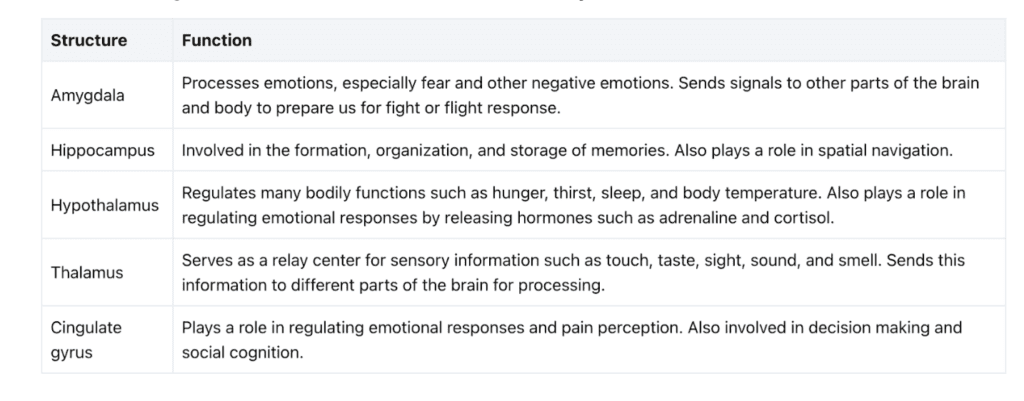Are you a parent of a tween or teen who is looking for an engaging and educational movie to watch with your child? Look no further than the Pixar film, Inside Out. Educators you can also use this movie in our classrooms to teach students about emotional intelligence and empathy. We can also use it as a tool for discussing mental health issues like depression and anxiety.
Overall, “Inside Out” is a great reminder of the importance of building emotional connections with those around us. Whether it’s with our children or our students, taking the time to understand their emotions can make all the difference in their lives.
This movie takes viewers on a journey through the mind of an 11-year-old girl named Riley, where we meet her five emotions: Joy, Sadness, Anger, Fear, and Disgust
But did you know that this movie also has ties to our nervous system? According to neuroscientists, Inside Out does an excellent job of illustrating the complexity of our emotions and how they are connected to our brain function. The film shows how different parts of our brain work together to create memories and influence our behaviour.
So not only is Inside Out a fun and entertaining movie for tweens and teens, but it also provides a valuable lesson about emotional intelligence and the inner workings of our nervous system.

Our nervous system is a complex network of nerves and cells that transmit signals between different parts of our body. It is responsible for controlling all of our bodily functions, including our emotions. In this article, we will explore how our emotions are controlled by the brain and nervous system, and discuss how accurately the film portrays the complexity of our emotions.
Our emotions are controlled by a part of the brain called the limbic system, which is made up of several structures including the amygdala, hippocampus, and hypothalamus. These structures work together to regulate our emotional responses to different stimuli.
When we experience an emotion such as fear or happiness, it triggers a response in the limbic system. The amygdala, for example, is responsible for processing fear and other negative emotions. It sends signals to other parts of the brain and body to prepare us for fight or flight.
The hypothalamus is another important structure in the limbic system. It regulates many bodily functions such as hunger, thirst, and sleep. It also plays a role in regulating our emotional responses by releasing hormones such as adrenaline and cortisol.
Overall, our emotions are controlled by a complex interplay between different structures in the brain and nervous system. This helps us respond appropriately to different situations and stimuli (can also be known as activators or triggers).
The different structures of the limbic system and their functions
The limbic system is a complex network of structures that work together to regulate our emotional responses to different stimuli. Each structure plays an important role in controlling our emotions and bodily functions.
The autonomic nervous system is a division of the peripheral nervous system, which is part of the limbic system. The autonomic nervous system has two branches – the sympathetic and parasympathetic systems – that work together to regulate many physiological processes, including digestion, heart rate, breathing, and blood pressure.
The amygdala processes emotions such as fear and other negative emotions while sending signals to other parts of the brain and body to prepare us for fight or flight response.
The hippocampus is involved in memory formation, organization, and storage while also playing a role in spatial navigation.
The hypothalamus regulates many bodily functions such as hunger, thirst, sleep, and body temperature while also releasing hormones like adrenaline and cortisol that play a role in regulating emotional responses.
The thalamus serves as a relay center for sensory information like touch or taste which it then sends on to different parts of the brain for processing.
Finally, the cingulate gyrus is responsible for regulating emotional responses like pain perception while also being involved with decision making and social cognition.
Overall each structure works together within the limbic system allowing us to respond appropriately during various situations we may face throughout life.


One example from the movie that accurately portrays the complexity of our emotions is how different memories can have both positive and negative emotional associations. For instance, when Riley recalls her former home in Minnesota, she initially feels happy and nostalgic. However, this memory quickly turns sad when she realizes that she may never return to that place again. This scene shows how complex our emotional responses can be to even a single memory.
Another example from the movie is how certain events or situations can trigger multiple emotions simultaneously. For instance, when Riley runs away from home in San Francisco, she feels scared and sad but also relieved to escape her problems temporarily. This scene demonstrates how multiple emotions can be triggered by a single event or situation.
Inside Out portrays the complexity of human emotions by showing how they interact with each other and influence our behavior in various ways. By using different characters to represent specific emotions and showing their interactions within Riley’s mind, the movie provides a compelling representation of how we experience and navigate through our feelings in everyday life.
Transitions can have a significant impact on young people as they navigate through various changes in their lives. Coping with change can be challenging, and different emotions may arise during the process. The movie “Inside Out” provides an insightful representation of how young people cope with transitions and deal with different emotions.
One example from the movie is Riley’s move to San Francisco. This transition significantly impacts her emotional state as she leaves behind her friends, home, and familiar surroundings. As a result, she experiences a range of emotions such as sadness, fear, and anger. These emotions affect her behavior and how she interacts with others.
In the movie, Joy attempts to control Sadness by trying to keep her away from Riley’s core memories. However, this strategy backfires as it leads to more chaos and confusion within Riley’s mind. Eventually, Joy realizes that both emotions are necessary for coping with change. This realization highlights the importance of acknowledging and accepting different emotions during times of change.
The movie also shows how coping mechanisms can vary among individuals based on their personality traits and life experiences. For instance, some characters in the movie are better equipped to handle change than others due to their temperament or past experiences or having a support network and a safe other.
This film highlights how transitions can impact young people’s emotional well-being and highlights the importance of acknowledging and accepting different emotions during these times. By showing both positive and negative aspects of change through its characters’ experiences, “Inside Out” offers valuable insights into how young people can navigate through transitions effectively – whether that’s school transitions or at home with family or friends.
As a parent of a teenager, I understand the importance of fostering meaningful conversations about emotions. Watching Pixar’s Inside Out is a great way to start these dialogues and help your teen gain insight into their inner world. As a bonding exercise you could watch the film with your teen and then spend some time discussing the film. These questions below are designed to get the conversation started by breaking down some major concepts from the film. Teens can explore their feelings and learn how to accept them and build resilience against difficult emotions. Parents can also use these questions below as an opportunity to connect with their children, open up dialogue about any worries or fears they have, and provide support.


Driven to improve the emotional wellbeing of young people, adults, and parents, Yasmin Shaheen-Zaffar is the founder and creator of Polyvagal Teen®. She also developed The R.U.D Process® – a practical, step-by-step approach that helps teens and adults recognise and manage stress and anxiety by becoming Polyvagal Aware.
In addition, Yasmin leads several social-impact initiatives that promote steady, consent-based communication and co-regulation:
Glad We Talked® programmes
Neurosloth® Academy
Talky Talk Cards
Scribbledeedo®
World Stop Shouting Day – a campaign to reduce conflict and aggression in everyday interactions
Alongside this work, Yasmin runs a small private counselling practice in North Yorkshire and online, specialising in emotional regulation and working with neurodivergent, multi-faith, and mixed-heritage clients.